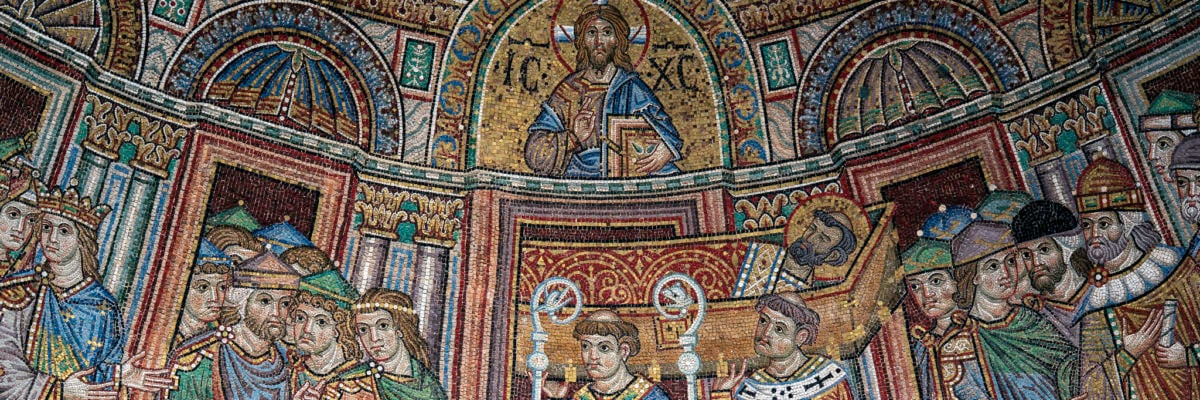
Tradition records that the author of one of the Gospels was named Mark. This tradition goes back to the first century, when it became necessary to distinguish the different Gospels being written from each other. The way chosen was to use their authors’ names. Thus, we got “the Gospel according to Mark.”
A figure named Mark is mentioned in Acts and in several New Testament letters. However, since Mark (Latin, Marcus) was one of the most common names in the Roman world, some have questioned whether these passages refer to the same individual.
The evidence is that they do. The New Testament indicates there was a companion to apostles like Peter, Paul, and Barnabas who could be referred to simply as “Mark,” without further qualification. That shows that there was only one individual by this name who was an apostolic companion.
We first meet Mark around the year A.D. 43. At the time, Peter had been miraculously freed from prison in Jerusalem, and “he went to the house of Mary, the mother of John whose other name was Mark, where many were gathered together and were praying” (Acts 12:12).
Like many people of the day, Mark had two names: His Jewish name was John, and his Latin name was Mark. Since there were many Johns in the early Christian community, he became best known by the latter name.
Mark’s father was probably dead because his mother, Mary, was the householder. The family were probably upper-class, as they had a household large enough to accommodate the “many” Christians who had gathered to pray. Their upper-class status also is indicated by the fact that they had a servant girl, named Rhoda (v. 13).
Also in Jerusalem at this time were the apostles Barnabas and Paul, and Mark made an impression on them. When they returned to their missionary home base of Antioch, they took Mark along. This would have been an exciting opportunity for a young man, as Antioch was the third largest city in the world (after Rome and Alexandria, Egypt).
They didn’t stay there long. In A.D. 44, the Holy Spirit directed Barnabas and Paul to conduct their first missionary journey (Acts 13:1-3), and they brought Mark with them.
The trio sailed to the island of Cyprus, and after evangelizing there, they moved on to the southern coast of what is now Turkey. However, Mark decided to return to Antioch—perhaps not liking the rigorous travel conditions.
In A.D. 48, Barnabas and Paul returned to Antioch, and the next year, they planned to embark on the second missionary journey. However, they got in a huge argument, and the subject was Mark.
Although Barnabas was a native of Cyprus (Acts 4:36), he was also Mark’s cousin (Col. 4:10), and he wanted to bring Mark with them and give him another chance as an evangelist.
“But Paul thought [it] best not to take with them one who had withdrawn from them in Pamphylia and had not gone with them to the work. And there arose a sharp contention, so that they separated from each other” (Acts 15:38-39).
This must have been a huge fight! Barnabas and Paul had been companions for years, and now they were dissolving their partnership!
Paul then embarked on the second missionary journey, while Barnabas took Mark and conducted his own missionary journey on his native island of Cyprus (Acts 15:39), though we know nothing more about it.
At some point, likely in the early 50s, Mark became the traveling companion of Peter. According to the first-century figure known as John the Presbyter, Mark served as Peter’s interpreter—likely meaning he helped translate Peter’s speeches from Aramaic into Greek.
Based on his memories of Peter’s preaching, Mark then wrote his Gospel (Eusebius, Church History 3:39:15-17). Although many hold that Mark was written between A.D. 65 and 70, my own calculations indicate that it was a decade or more earlier, around 55 (Jimmy Akin, The Bible Is a Catholic Book).
Mark’s Gospel is curious in several ways. Despite portraying Jesus as a great teacher, it includes few of his teachings. It also does not contain information about his birth and upbringing, which one would expect in a Greco-Roman biography. Most startlingly, it does not contain accounts of the post-Resurrection appearances of Jesus to the disciples. (Older and better manuscripts of Mark cut off at 16:8, before the Resurrection appearances, and the last twelve verses show signs of being a later, but still early, composition.)
This has led some to speculate that Mark’s original ending was lost. However, a more recent hypothesis is that Mark was not trying to produce a finished literary work. Instead, he was composing a set of notes that could be polished and then published by other people.
This was a known form of Greco-Roman literature. Such unpolished note collections were known as hypomnemata (Greek, “memoirs”), and if that’s what Mark was writing, it would explain why his Gospel is so unusual. It also would explain why Matthew and Luke then took Mark and used it to produce their own polished and expanded Gospels.
This theory would explain why John the Presbyter says Mark wrote down the stories Peter told accurately but not in good literary order, whereas Matthew did. It also would explain Clement of Alexandria’s statement that Mark wrote for a private group of individuals, while Matthew’s and Luke’s Gospels were “published openly” (Greek, progegraphthai) (Eusebius, 6:14:5-7).
Peter had begun his ministry in Rome by the 50s. In A.D. 58, Paul also arrived in Rome, where he spent two years under house arrest, awaiting trial before Nero. During that period, Luke interviewed the two great apostles and used the material to compose his own Gospel and the book of Acts.
Mark’s presence in Rome is why Luke can count on his audience to already know the identity of “John whose other name is Mark” (Acts 12:12).
Paul also wrote during his house arrest. One of the letters he composed was Philemon, and he includes greetings from Mark (v. 24). Another letter of this period was Colossians, which includes greetings from “Mark the cousin of Barnabas (concerning whom you have received instructions—if he comes to you, receive him)” (4:10).
This shows that Mark had redeemed himself in Paul’s eyes and was now being entrusted with pastoral assignments to distant locations like Colossae, located in modern Turkey.
After Paul was released following his first trial in Rome, Mark remained in the imperial capital. He was still there around A.D. 64, when Peter wrote, “She who is at Babylon, who is likewise chosen, sends you greetings; and so does my son Mark” (1 Pet. 5:13). The fact that Peter refers to Mark as his spiritual son indicates that an especially close relationship had developed between them.
In July of A.D. 64, the Great Fire of Rome broke out. This proved disastrous for the Christian community, as the emperor, Nero, decided to blame the fire on Christians. By 65, he was openly persecuting them, and he martyred Peter in A.D. 65 or 66.
Paul also was taken into custody again and reimprisoned in Rome. In 66, knowing he was soon to die, he wrote his final letter and paid special tribute to Mark, telling Timothy, “Get Mark and bring him with you; for he is very useful in serving me” (2 Tim. 4:11).
After Paul’s martyrdom in A.D. 67, tradition records that Mark went to Egypt, where he became the first bishop of the church of Alexandria.
An interesting tradition about Mark is preserved in a document known as the Anti-Marcionite Prologue to Mark. It states that he “was called Colobodactylus” (Greek, “Stumpy-Fingered”), because he had fingers that were too small for the height of the rest of his body.
All told, Mark has an inspiring story of redemption. After his early failure, he was taken under the wing of his cousin and grew to become an assistant to the prince of the apostles. He redeemed himself in the eyes of his harshest critic, and he became the author of an inspired Gospel!
Image: Translation of the Body of St. Mark, Porta di Sant’ Alipio (north portal), west façade, c. 1270-75, mosaic (Basilica di San Marco, Venice). Steven Zucker, Smarthistory co-founder via Flickr, CC BY-NC-SA 2.0 (cropped).



